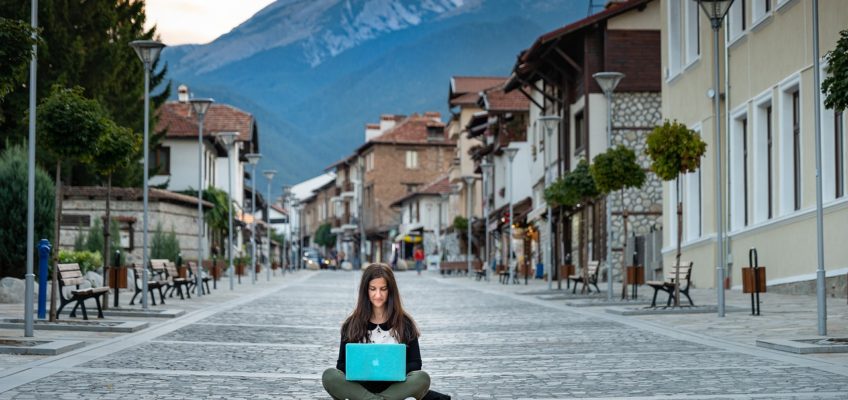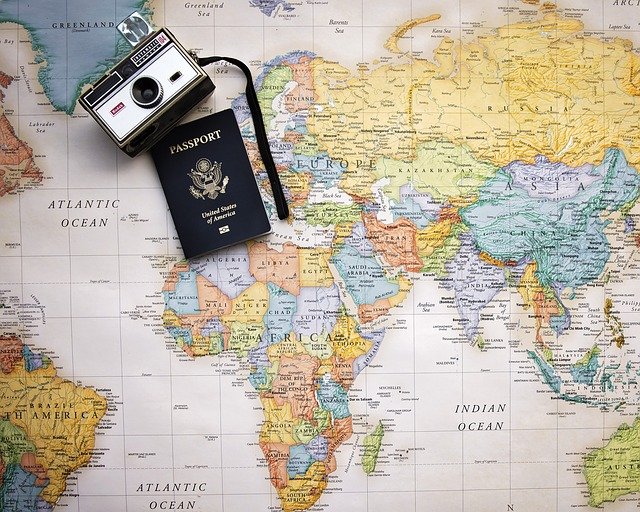Imagine spending winter in Thailand, spring in Spain, summer in Croatia, and autumn in Peru. All while working and enjoying a comfortable and adventurous lifestyle.
That is the life of a “digital nomad.”
What is a “digital nomad” you ask? The term appears to have originated in 1997 with the book entitled Digital Nomad by Tsugio Makimoto. According to Reddit:
“Digital Nomads are individuals that leverage technology in order to work remotely and live an independent and nomadic lifestyle.”
The digital nomad lifestyle has become one of the hottest strategies for combining work, life, travel, and adventure. While it’s very popular with the Millennial crowd, anyone at any age or career stage can make it happen.
So how does one pull off being a digital nomad? It’s not easy, but it’s definitely doable if you strategize and plan wisely.
Finding a Remote Job
The first step is to find or create a job that you can do remotely that doesn’t require your physical presence. In today’s tech world, there are a myriad of possible options.
My friend and fellow blogger, Ryan Robinson, recently put together a great list of side businesses that can be done remotely with his 65 Best Businesses to Start While Working a Full-Time Job.
Although it’s written from the perspective of earning side revenue while working full-time, almost all of the ideas can be applied to the digital nomad lifestyle.
Here are just some of the remote job ideas: graphic design, web design, web development, online courses, online coaching, podcasting, writing ebooks, Amazon reselling, affiliate marketing, English teacher, blogger, and much more.
You can also find a number of remote jobs on freelance sites and remote job boards. Some of the top freelance sites are Upwork (formerly eLance & oDesk), 99 Designs, and Fiverr.
Remote job boards include WeWork Remotely, FlexJobs, and Working Nomads.
If you’re currently employed, you can try asking your employer about remote working options. Many tech companies are used to working with employees, contractors, and vendors in other cities and countries. A couple of jobs that work well remotely are developers and designers.
It doesn’t cost you anything to ask, and you never know - your boss may be fine with it. You can even sell them on the fact that you’ll save them space and money, since you won’t be using a desk at the office or using any of the office resources.
Selecting the Best Countries
The best countries for digital nomads share several characteristics: low cost of living, nice weather, plenty of things to do, fast and accessible wifi, availability of co-working spots, and are safe and friendly.
Nomad List does a great job ranking cities worldwide for digital nomads. Their primary rankings are based on cost, weather, air quality, fun, and safety. You can also filter for fast wifi, female friendly, and great nightlife.
Another great resource is International Living’s Best Places to Retire list. They rank on cost of living, fitting in, entertainment & amenities, healthcare, infrastructure, and climate.
You can also get some good ideas by reviewing lists of top countries for traveling on a budget.
Taking all the rankings into consideration, the three regions that make great locations for digital nomads are Southeast Asia, Central & South America, and parts of Europe.
Southeast Asia: Thailand has always been popular for digital nomads, especially Chiang Mai, Bangkok, and Phuket.
Thailand’s not the only great spot in SE Asia. Other countries to explore or consider are Indonesia, Cambodia, Vietnam, Laos, Nepal, Malaysia, the Philippines, and India.
Central & South America: The top countries in Central America are Nicaragua, Guatemala, Honduras, Panama, Mexico, and Costa Rica.
For South America, the best digital nomad locations are mainly along the Pacific coast: Chile, Ecuador, Peru, Colombia, and Uruguay.
International Living’s report ranked Ecuador #1 for retiring abroad:
“A doctor’s visit will set you back around $10, while a main course in a restaurant can be had for as little as $2.50. The bus trip from Cotacachi to Otavalo will cost you 25 cents. For big-ticket items like real estate, you can get a lot more for your dollar here than in the U.S. A couple can live well here on $1,400 a month, including rent.”
Europe: The European Union is the most diverse collection of countries on the planet with 28 countries and 24 official languages. While all of these nations are worth visiting, not all of them are ideal for digital nomads.
The ideal European countries for digital nomads are Spain, Portugal, Italy, Serbia, The Czech Republic, Hungary, Croatia, Greece, and Malta.
Some of the best European cities to consider are Las Palmas, Spain (ranked #1 on Nomad List); Budapest, Hungary; Belgrade, Serbia; Thessaloniki, Greece; Prague, Czech Republic; Porto, Portugal; and Zagreb, Croatia.
Find a Co-Working Space
Another important feature to look for are available co-working spaces. These can be as a basic as a nice coffee shop with good wifi all the way to full live-work accommodations.
If you just want a good work space, there are a number of options. For Asia, check out Hubud in Bali, Indonesia; Punspace in Chiang Mai, Thailand; or Angkor Hub in Siem Reap, Cambodia.
In Europe, check out Impact Hub in the Czech Republic or Porto i/o in Porto, Portugal.
In Central & South America, there’s Cocovivo in Bocas del Toro, Panama; or Cowork in Chile, Uruguay, and Colombia.
For full accommodations, check out The Surf Office in Lisbon, Canary Islands, and Santa Cruz, CA. It’s geared around surfing communities, so you can mix up working and enjoying the ocean each day.
Two additional full-accommodation options are Coconat Space, just outside of Berlin, Germany and Mutinerie in Paris, France.
Another great option is with a company called Remote Year. It launches on February 1st each year and goes to twelve different worldwide locations (a different one each month). They divide into three legs: South America, Europe, and Asia. For $2000 per month, they provide the travel, accommodations, work space, and activities and events.
Making it all Work
No matter which locations and work space options you choose, you’ll need to take care of some things at home before you take off for your digital nomad adventure.
First, make sure to set up all your bills and commitments to be paid and taken care of automatically online. You don’t want to have to worry about forgetting a random payment or dealing with International mail.
Secondly, take an inventory of anything that you can’t take with you. Of these items, how many of them do you truly need? Seriously consider selling these items, especially big ticket items like a car. That car is only going to depreciate in value while you’re gone, so why not cash it out and use that money for your travels.
Thirdly, look into renting out, sub-letting, or Airbnb-ing your home or apartment if possible. This can be another fantastic source of income to help supplement your adventure.
Once you do start working remotely, there are some practices to make your life easier. While it may be tempting to go surfing or partying all day, try to get into a regular work routine. Even if it’s only for four hours a day, you’ll feel better knowing you put in some work time each day.
You’ll probably also find there will be times when you have to work unusual hours due to time differences back home. Keep this in mind and work it into your schedule so you don’t lose too much sleep or knock yourself off your regular routine.
And lastly, there are a number of fantastic productivity tools that will help you in your life as a digital nomad. Communicate with co-workers, customers, and vendors with Slack, Google Hangouts, Skype, and Viber.
Organize your work on the cloud with Google Drive, Dropbox, and Asana. Stay focused with RescueTime and Alfred. And ensure you have access to a wifi hotspot with Boingo.
Final thoughts
The digital nomad lifestyle isn't for everyone, but it can be very rewarding for those adventurous enough to give it a try. When you're not working a structured 9-to-5 you have a lot more time and flexibility to enjoy life.
If you need ideas, just check out all the amazing experiences on Experiencify. You can explore ancient temples & ruins in Southeast Asia; wonders of nature in Asia and South America; and road trips in Europe.
Who knows, you may decide never to go back to a conventional “real job” again!
Note: If you're serious about being a digital nomad, get fully prepared with our Digital Nomad Toolkit.




